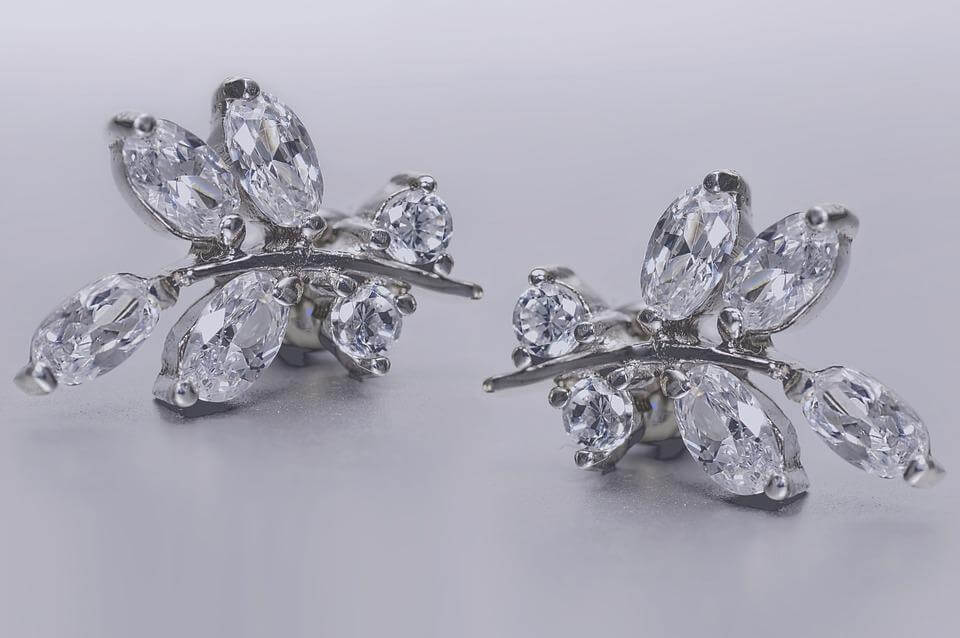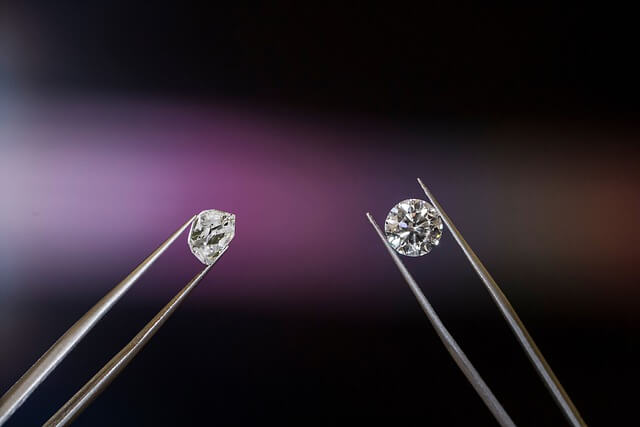Information on cutting, polishing, grading, marketing of diamond. Information on synthetic diamonds.

The mining of diamonds is similar to the mining of other minerals. However, the crystals are never abundant in any secondary occurrence and are so widely scattered through the kimberlite that the grade of rock seldom can be determined in advance—as can often be done with metal-bearing ores, for example.
Recovery:
Both open-pit (surface) mining and underground mining of diamonds are conducted. The Kimberley pit went down more than 1,000 feet (300 meters), after which shafts were sunk to a depth of 3,520 feet (1,050 meters). During slack times the recovered rock may be crushed, spread over the ground, and allowed to weather for some months. Usually, however, the rock is put through a series of mechanical operations that have been developed in the past 100 years.
After the rock is broken into pieces underground, the pieces that are still too large are removed when they fail to pass through sets of iron bars collectively called a grizzly. The large pieces are crushed again and join the smaller rock that has passed through the grizzly.
Washing frees the rock of clay, grit, and sand, and the two fractions thus obtained are treated differently. The coarser material is given a sink-and-float treatment. It is placed in a conical tank containing a dense fluid, where the heavier material sinks to the bottom; a second treatment of the same kind but in a still denser medium isolates the diamonds. The finer material (clay, grit, and sand) is placed in a bed of pebbles lying on a sieve and is shaken up and down by a pulse of water forcing diamonds to the bottom of the bed.
The diamond concentrate obtained by these processes goes next to grease tables. These tables, which utilize diamond’s peculiar property of adhering to grease but not to water, are sloping, vibrating sheets of metal. The sheets are covered with petroleum jelly, and they hold the loose diamonds until they are scraped off and boiled free. Lastly, the crystals are hand-picked and carefully cleaned. Sorting and grading take place before any cutting is done.
Diamonds in secondary deposits may be recovered in different ways. A great thickness of overburden may have to be removed, and the bedrock may even be hand-brushed or vacuum-cleaned. Electrostatic methods sometimes are used to recover tiny diamonds. Lone prospectors employ a simple gold pan or some local substitute.

Cutting and Polishing:
Diamond is the only mineral that can be cut and polished in the same operation. The process is one of simple abrasion. The octahedral shape of most crystals lends itself perfectly to the popular “brilliant” cut, but many stones are cut without regard to this relationship of shapes.
The chief complication in cutting has to do; with the presence of the octahedral cleavage. The cleavage makes possible the easy trimming of a specimen to reduce its size and eliminate flaws, but it also makes necessary a careful orientation of the crystal. No facet can be placed exactly parallel to a cleavage surface, because such surfaces have a pearly luster. Separation in any direction except along a cleavage plane is accomplished by sawing, i crystal may be cleaved several times, or cleaving may be combined with sawing operations.
A crystal selected for cutting must first 1 examined carefully to determine its shape ar cleavage. Before cleaving, a small groove is cut into an edge of the crystal with a diamond cutting tool. A thin blunt knife called a cleaving iron is then set in the groove, parallel to the desired cleavage, and is struck a sharp blow; the crystal breaks apart. Before sawing, the desired cuts are outlined in ink on the crystal. The diamond saw is a thin disk of phosphor bronze that is rotated vertically at high speed and fed with a mixture of diamond powder and olive oil. After cleaving and sawing, the diamond is roughly ground to shape it; a lathelike machine is used for this purpose.
The placing of facets on a diamond is done with a rotating horizontal disk called a lap, made of soft iron and treated with diamond powder and oil. The stone is placed in a holder called a dop, to which it is attached with solder or held with steel claws. Mechanical devices enable the cutter to set the diamond in various positions against the lap, to give it the desired facets. The stone is boiled in acid to clean it.
The most popular diamond cut is the diamond brilliant. This familiar rounded cut has 58 facets. There are 33 facets in the crown above the equatorial line (or girdle) and 25 in the pavilion below. The top facet, called the table, is the largest. It is surrounded by 24 triangular facets and 8 four-sided facets. The bottom facet, called the culet, which is needed only to prevent chipping, is surrounded by 16 triangular and 8 five-sided facets. The brilliant cut follows standardized laws of mathematical optics fairly closely. Additional facets or special patterns occasionally are applied to large or otherwise unusual stones.
Begun in India and perfected in Italy, diamond cutting is one of the most skilled and highly paid crafts. Belgium, Luxembourg, and the Netherlands are well known for their diamond-cutting establishments, which are concentrated in Antwerp and Amsterdam. France and West Germany ship nearly as many cut diamonds to the United States as the Netherlands does. Diamond-cutting now has spread to Israel, India, and the Republic of South Africa. Some cutting, especially of better stones, also is done in London, New York, and elsewhere.

Source: pixabay.com
Grading:
Gem diamonds are graded and priced according to four factors: perfection, color, cutting, and size. The absence of flaws is important because cracks, inclusions, and so-called carbon spots (which may be places where the carbon has failed to crystallize or has become graphite) prevent the free passage of light. Some carbon spots have proved to be places where nitrogen atoms substitute for carbon in the crystal lattice. Perfect diamond is generally an unacceptable trade term, because perfection is impossible to attain, but it is permitted for a stone that reveals no flaws to the trained eye under a 10-power magnifier.
Color is an essential factor in grading, because it is directly related to the degree of rarity. A yellow or brown cast is undesirable unless the hue is distinctive enough to be favorably regarded as a “fancy” color. Pink, bluish, violet, green, and other attractive hues bring premium prices. Blue-white is another trade term that is not much in favor, but it can properly be used to mean the absence of yellow.
Cutting can bring out the best features of a diamond, so it is always a substantial part of the cost of a gem diamond. Finally, size is an obvious factor in the price of a diamond. A two-carat stone is worth more than twice as much as a one-carat stone of equal quality, and the price ratio increases rapidly with the size.
Marketing:
Control of about 80% of the world’s production is in the hands of the De Beers Central Selling Organisation, which combines three seperate groups that deal in gemstones, industrial stones, and the output of independent producers. The producers of the other 20% sell to whomever they please. About 150 individuals and companies handle the marketing of diamonds; they buy the rough diamonds in parcels and allot sales to cutters and others. (Switzerland is a major middleman in the sale of rough stones.) The distribution of diamonds is a rather tightly held monopoly, a system that is favored by the miners and the governments concerned. Certainly it has the effect of maintaining stable prices.
SYNTHETIC DIAMONDS
In the United States in 1954 the General Electric Company succeeded in crystallizing diamonds synthetically. There is some evidence, however, that this remarkable feat was achieved a little earlier in Sweden; still older claims have not been adequately verified. Synthetic diamonds are now also produced in Ireland, South Africa, the USSR, Czechoslovakia, and Japan.
The basis for the General Electric experiments was the work of the American physicist Percy W. Bridgman on high-pressure physics. Bridgman showed that when high temperatures and high pressures are combined, diamond rather than graphite is the stable form of carbon; the reverse is true at high temperatures and low pressures. In producing synthetic diamonds, extremely high values are obtained for both heat and pressure, and the raw material can be any convenient form of carbon (even the carbon in peanut butter has been used). The presence of nickel or other metallic elements speeds the reaction.
Another method of synthetic diamond production was developed through study of the presence of diamonds in meteorites. Such diamonds apparently originate either in an explosion or in a collision of the parent body in space, or else in the impact of the meteorite on the earth’s surface. New minerals have been found associated with meteorite craters, and this association has encouraged the further study of meteoritic diamonds. As a result, a hexagonal form of diamond was discovered in 1967 and given the name lonsdaleite. In 1968 the Du Pont company put on the market a synthetic diamond powder made under a blanket of high-velocity plastic explosive, producing alternating layers of isometric and hexagonal diamond.